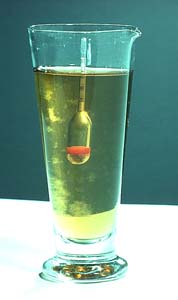Density (specific gravity) and osmolality
The density of urine represents the kidney’sdilution and concentration capacity, which is critical to the maintenance of the hydro-electric balance (homeostasis). It corresponds to the proportion of elements dissolved in the urine related to the volume of the sample. Density is temperature dependent and should be measured at 20°C. The specific weight is expressed in g/ml, or kg/m3 (international units or SI).
Routine screening and evaluation of density by test strips are convenient and easy to perform. This gives a rough estimate of the concentration of urine. However, the precision of the test strip method presents significant variations.
 The aerometer (urometer) is an obsolete measuring instrument. Nevertheless, it is still used in many places.
The aerometer (urometer) is an obsolete measuring instrument. Nevertheless, it is still used in many places.
The urometer sinks as a function of the volume of urine displaced. The density value is given by the liquid-air junction visible on the instrument rod. The urometer must float freely and the measure must be performed at 20°C.
Results obtained with a urometer present a high number of errors, even if the measure is performed correctly. Therefore, this method is not recommended .
An exact measurement of the density is obtained with a refractometer. This instrument measures the refractive index of urine, which depends on the number of molecules dissolved. A few drops of urine are sufficient for the measure. The instrument is calibrated to give directly the specific gravity of urine. The refractive index must be corrected in the presence of proteinuria or glucosuria. Adhere strictly to the manufacturer’s instructions.
Tests strips are satisfactory for routine measures of the density.
Reference values: 1.003-1.030 g/mL (possibly higher)
Density variation:
- Eusthenuria: 1.010-1.030 g/mL.
- This is the normal value. Morning urine density of a healthy individual is 1.020 g/mL (more in cases of restricted liquid intake during the night)
- Hyposthenuria : < 1.010 g/mL
- Hypersthenuria: > 1.030 g/mL
- Isosthenuria: Urine has a constant density around 1.010 g/mL, independently of the volume. Severe kidney pathology induced a loss in concentration and dilution capacity.
The measurement of specific gravity also allows for the estimation or the precise measurement of the amount of absorbed liquid (for instance during treatment of renal calculi), or the detection of a possible fraudulent dilution to mask the presence of drugs.
Creatinine should also be measured in parallel.
Clinical relevance
Decreased specific gravity
- Diabetes insipidus of central or peripheric origin: a deficiency of antiduretic hormone (ADH, secreted by hypoophisis) or a defect of ADH receptors increases the water permeability of the distal and collecting duct tubules. Large volumes of urine with a specific gravity around 1.002 g/mL are voided.
- Diseases of the renal parenchyma with tubulopathy such as pyelonephritis, polycystic kidney and hydronephrosis
- Severe hypokaliemia
- Hypercalcemia of various origin
Increased specific gravity
- Massive dehydration (perspiration, fever, vomiting, diarrhea)
- Insufficient liquid intake (absence of thirst perception)
- Adrenal insufficiency
- Hepatic pathology
- Cardiac insufficiency
See also chapter "Chemical analysis".
Osmolality
Osmolality is the measurement of the number of osmotically active particles (Osmol) per unit of water (Osmol/kgH20) or per volume of the solution medium (Osmolarity). It depends only on the number of dissolved particles and not on their shape or dissociation mode.
Homeostasis, i.e. the maintenance of a constant volume depends on the hydro-electric balance implying three coupled regulations :
- Acid- base equilibrium
- Electrolyte equilibrium
- Osmotic equilibrium
Osmolality of a solution is measured by the decrease in its freezing point (cryoscopy).
Principle
The sample is rapidly cooled to 6° C (Pelletier effect). A vibrating metal thread solubilizes the formed crystals, which produces heat and induces an increase in the sample temperature ending in a plateau. The difference between 0°C and the temperature at the plateau is taken as the value of the decrease in freezing point. The temperature is measured electronically and the result is displayed directly in mosmol/kg.
Reference values
Adults: 500-1200 mosmol/kg H2O
Maximum in cases of dehydration ~1400 mosmol/kg H2O
Minimum in cases of aqueous diuresis ~40 mosmol/kg H2O
Newborns: 40-250 mosmol/kg H2O (Day 1g: 9-400 mosmol/kg H2O)
Infants: 500-600 mosmol/kg H2O